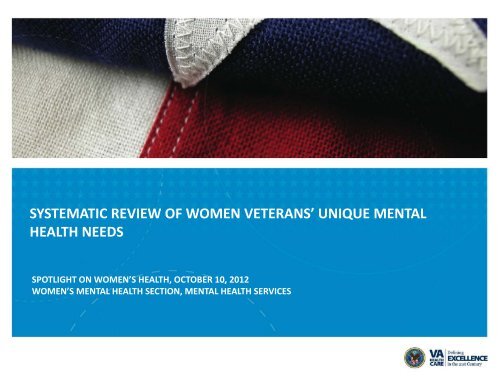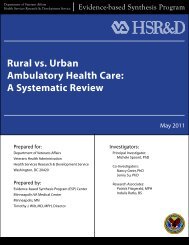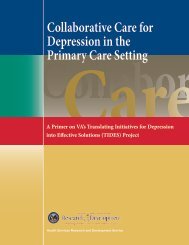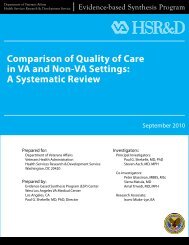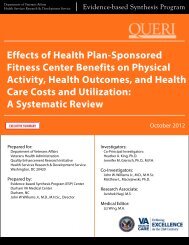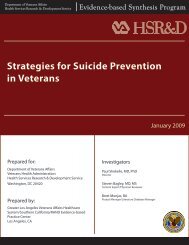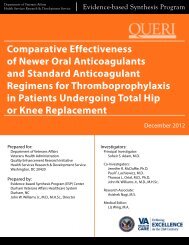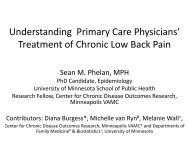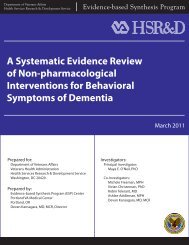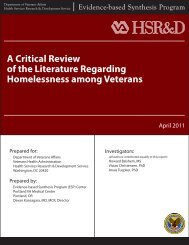SYSTEMATIC REVIEW OF WOMEN VETERANS' UNIQUE MENTAL ...
SYSTEMATIC REVIEW OF WOMEN VETERANS' UNIQUE MENTAL ...
SYSTEMATIC REVIEW OF WOMEN VETERANS' UNIQUE MENTAL ...
You also want an ePaper? Increase the reach of your titles
YUMPU automatically turns print PDFs into web optimized ePapers that Google loves.
<strong>SYSTEMATIC</strong> <strong>REVIEW</strong> <strong>OF</strong> <strong>WOMEN</strong> VETERANS’ <strong>UNIQUE</strong> <strong>MENTAL</strong><br />
HEALTH NEEDS<br />
SPOTLIGHT ON <strong>WOMEN</strong>’S HEALTH, OCTOBER 10, 2012<br />
<strong>WOMEN</strong>’S <strong>MENTAL</strong> HEALTH SECTION, <strong>MENTAL</strong> HEALTH SERVICES
Acknowledgements<br />
• Investigators:<br />
Jennifer Strauss<br />
Jennifer Runnals<br />
Natara Garovoy<br />
Monica Mann‐Wrobel ‐<br />
Susan McCutcheon<br />
Allison Robbins<br />
Alyssa Ventimiglia<br />
VISN 6 Mental Illness Research Education and Clinical Centers Women Veterans<br />
Workgroup<br />
• Contributors: Jenny Hyun, Kathleen Iverson, Jan Kemp, Linda Lipson, Isomi Miake‐Lye,<br />
Paul Shekelle, Dawne Vogt and DoD/VA Integrated Mental Health Strategy, Strategic<br />
Action #28 (Gender Differences) Work Group<br />
VETERANS HEALTH ADMINISTRATION
Agenda<br />
• Provide overview of women Veterans’ mental health<br />
• Introduce DoD/VA Integrated Mental Health Strategic<br />
Action #28 — Gender Differences<br />
• Present current evidence review<br />
• Identify next steps<br />
• Highlight new resources available<br />
VETERANS HEALTH ADMINISTRATION
Women Veterans Mental Health: Overview<br />
• Women Veterans are the fastest growing segment of eligible VHA users<br />
• Yet, they continue to be a minority of VA users as compared to male Veterans<br />
• As such, women Veterans may face unique challenges<br />
• VA offers a full continuum of mental health services:<br />
– Outpatient: assessment, evaluation, psychiatry, individual and group therapy<br />
– Specialty services: posttraumatic stress disorder (PTSD), substance use disorders,<br />
depression, homelessness<br />
– Evidence‐based therapies available at all VA medical centers<br />
– Inpatient and residential treatment options (mixed gender and women only)<br />
VETERANS HEALTH ADMINISTRATION 4
Single Gender Versus Mixed-Gender Programs<br />
• VA recognizes that some Veterans will benefit from treatment in an environment<br />
where all of the Veterans are of one gender<br />
– May help address a Veteran’s concerns about safety<br />
– May improve a Veteran’s ability to disclose and address gender‐specific concerns<br />
– May enhance treatment engagement and social support<br />
• VA also recognizes that mixed‐gender programs have advantages<br />
– May help Veterans challenge assumptions and confront fears about the opposite sex<br />
– May provide an emotionally‐corrective experience<br />
– Also promotes efficient use of resources: accepting both men and women helps prevent<br />
treatment or admissions slots from going unused<br />
– Women can and should have access to all services, and not be limited to women only<br />
treatment settings<br />
• Given these considerations, VA does not promote one model over another. The<br />
needs of a specific Veteran dictate which model is most clinically appropriate.<br />
VETERANS HEALTH ADMINISTRATION 5
Women-Only Programs<br />
• Women Veterans can receive services at all VA medical centers<br />
• Some facilities have established formal outpatient mental health treatment teams<br />
specializing in working with women Veterans<br />
• Specific offerings vary from facility to facility, based on local demand and resources<br />
• VA has residential and inpatient programs that provide treatment to women only<br />
or that have separate tracks for men and women<br />
VETERANS HEALTH ADMINISTRATION 6
Trends in Women Veterans’ Use of VA Mental Health Services<br />
and Clinical Presentations<br />
VETERANS HEALTH ADMINISTRATION
Top 10 Diagnoses: Female OEF/OIF/OND Veterans In VA<br />
2002-2012 (Q2=96,297)<br />
Diagnosis<br />
Percent of<br />
Women Presenting<br />
Musculoskeletal 56%<br />
Mental Disorders (e.g., PTSD, Non‐PTSD Anxiety, Depression) 51%<br />
Nervous System/Sense Organs 44%<br />
Genitourinary System 41%<br />
Digestive System 38%<br />
Respiratory 34%<br />
Endocrine System 32%<br />
Diseases of Skin 27%<br />
Injury/Poisonings 27%<br />
Infectious and Parasitic Diseases 20%<br />
VETERANS HEALTH ADMINISTRATION<br />
Sourced from Epidemiology Program, Post-Deployment<br />
Health Group, Office of Public Health, VHA, DVA
Women Veterans Mental Health: Operation Enduring<br />
Freedom/Operation Iraqi Freedom/Operation New Dawn<br />
(OEF/OIF/OND)<br />
Between 2002‐2 nd Quarter 2012:<br />
• 56.2% of discharged female OEF/OIF/OND Veterans have accessed VA care (versus<br />
54.2% of males)<br />
• 51.0% of female OEF/OIF/OND Veterans seen at VA received a mental health<br />
diagnosis (versus 53.0% of males)<br />
– Adjustment reactions (including PTSD) and depressive disorders among most frequent<br />
diagnoses for men and women<br />
– Adjustment reactions: 31.5% of women versus 35.5% of men<br />
– PTSD: 23.4% of women versus 29.1% of men*<br />
– Depressive disorders: d 27.1% of women versus 21.0% of men<br />
*Research on PTSD among OEF/OIF/OND Veterans suggests women are as resilient to<br />
effects of combat stress as men in the year following return from deployment<br />
VETERANS HEALTH ADMINISTRATION 9
Changing Patterns of Women Veterans’ Use of VA Mental<br />
Health Services<br />
Between 2005‐2010:<br />
• Number of women who received VA inpatient mental health care increased 19.7%<br />
• Number of women who received care at a VA Mental Health Residential<br />
Rehabilitation Treatment Program(MH RRTP) increased 47.4%<br />
• Number of women who received VA outpatient mental health care increased<br />
69.8%<br />
• Overall, proportion of women Veterans who received VA specialty mental health<br />
care increased 24.1% between 2005‐2010<br />
Women Veterans are increasingly accessing VA mental health services<br />
VETERANS HEALTH ADMINISTRATION 10
DoD/VA D/VA Integrated Mental Health Strategy (IMHS):<br />
Strategic Action #28 — Gender Differences<br />
• DoD and VA identified the need for an integrated strategy for the provision of<br />
mental health care to military service members, Veterans, and their families<br />
• IMHS resulted from recommendations from the 2009 DoD‐VA Mental Health<br />
Summit<br />
• 28 Strategic Actions focused on establishing continuity between episodes of care,<br />
treatment settings, and transitions between the DoD and VA<br />
• Workgroup assigned to each Strategic Action, includes VA and DoD clinicians,<br />
researchers, and policy experts<br />
VETERANS HEALTH ADMINISTRATION
DoD/VA D/VA Integrated Mental Health Strategy (IMHS):<br />
Strategic Action #28 — Gender Differences<br />
IMHS SA #28: Gender Differences<br />
• Explore gender differences in delivery and effectiveness of prevention and mental<br />
health care for women and for those with military sexual trauma (both genders)<br />
• Identify disparities, specific needs, and opportunities for improving treatment and<br />
preventive services<br />
Systematic evidence review<br />
VETERANS HEALTH ADMINISTRATION
Women Veterans’ Mental Health Research:<br />
Past and Current<br />
VETERANS HEALTH ADMINISTRATION
The Importance of Including Gender in Research<br />
• Different: Women Veterans experience greater rates of post‐deployment<br />
musculoskeletal, back problems, and joint problems than men (Haskell et al., 2012)<br />
• Similar: Women Veterans are as psychologically resilient to the effects of combatexposure<br />
as men (Vogt et al., 2011)<br />
• Unknown: Do women Veterans’ families experience the same or different effects of<br />
deployment as male Veterans’ families?<br />
VETERANS HEALTH ADMINISTRATION
Number of Publications i That Include Women Veterans And<br />
Mental Health Content<br />
50<br />
45<br />
40<br />
35<br />
30<br />
25<br />
20<br />
15<br />
10<br />
5<br />
0<br />
VETERANS HEALTH ADMINISTRATION<br />
Adapted from Bean‐Mayberry et al., 2010; excludes non‐mental health‐related citations.
Prior Reviews: Goldzweig et al. (2006)<br />
State of women Veterans health research<br />
•<br />
182 studies reviewed:<br />
– 2 randomized clinical trials (RCTs), 180 observational studies<br />
• Approximately half had a mental health focus<br />
– Predominantly PTSD and/or military sexual trauma (n = 43)<br />
• Key gender findings:<br />
– Predictors of PTSD similar for both genders (e.g., combat and sexual trauma)<br />
– Higher rates of mental/medical co‐morbidity among women<br />
– Women receiving primary care in a VA women’s clinics report greater satisfaction than<br />
those in general primary care<br />
VETERANS HEALTH ADMINISTRATION
Prior Reviews: Bean-Mayberry et al. (2010)<br />
Systematic review of women Veterans health research 2004‐2008<br />
• 195 studies reviewed<br />
– 5 RCT/experimental studies; all others descriptive/observational<br />
– 85 mental health (PTSD, depression, military sexual trauma)<br />
– 33 deployment/post‐deployment d l health h( (some overlap with ih mental health)<br />
h)<br />
• Key gender findings:<br />
– RCT of prolonged exposure and present‐centered therapy in women Veterans (N = 284);<br />
1 st VA multi‐site trial in women<br />
– As compared to men, OEF/OIF women are disproportionately and/or more affected by<br />
symptoms of PTSD, depression, and other mental health issues<br />
– For both women and men, assault histories prior to combat exposure was associated with<br />
a two‐fold increase in new‐onset PTSD symptoms<br />
– Knowledge gaps, gp particularly among VA non‐users, exist regarding g eligibility criteria and<br />
availability and quality of women’s health care<br />
VETERANS HEALTH ADMINISTRATION
Prior Reviews: Batuman et al. (2011)<br />
Health effects of military service on women<br />
• 44 studies reviewed<br />
– 5 RCT/experimental studies; all others descriptive/observational<br />
– 13 mental health (predominantly PTSD, depression)<br />
– OEF/OIF only<br />
• Key gender findings:<br />
– OEF/OIF women accessing less care for non‐PTSD related mental health disorders than<br />
men<br />
– Younger women less likely than younger males to use VA mental health services, whereas<br />
older women are more likely to use VA as compared to male counterparts<br />
– Suicide risk is lower among women Veterans versus males, but higher than non‐Veteran<br />
within the general population<br />
VETERANS HEALTH ADMINISTRATION
Current Review<br />
Systematic review of gender differences in mental health and the unique needs of<br />
women Veterans<br />
• Database search for articles related to women Veterans, published between<br />
January 2008 and July 2011, supplemented by bibliographic review and<br />
consultation with Subject Matter Experts (SMEs)<br />
• Employed same search terms and strategies as prior reviews<br />
‐ Included: peer reviewed articles focused on or including women Veterans and mental<br />
health<br />
‐ Examined: content included and organized by prevalence, risk factors, functional<br />
impairments, i healthcare utilization and barriers, and satisfaction with VA care<br />
VETERANS HEALTH ADMINISTRATION 19
Data Flow<br />
375 Articles identified<br />
288 rejected after abstract/title review<br />
87 articles full text review 55 rejected after full‐text review:<br />
27 Sample criteria not met<br />
6 Content criteria not met<br />
14 Study design not appropriate<br />
8 Overlap with prior evidence reviews<br />
32 articles assessed<br />
Screening and Prevalence of Mental Health Conditions (n=10)<br />
Risk Factors or Vulnerabilities Associated with Mental Health Conditions (n=7)<br />
Medical and Functional Impairment Associated with Mental Health Conditions (n=5)<br />
Mental Healthcare Utilization and Barriers to Care (n=11)<br />
Satisfaction with VA Care (n=2)<br />
VETERANS HEALTH ADMINISTRATION<br />
(not mutually exclusive categories)
Current Evidence Review: Results – Overview<br />
• Few intervention studies<br />
• Primarily VA healthcare users<br />
• Mixed‐gender but with preponderance of males<br />
• 18 studies used national databases<br />
– 13 studies used select VAs<br />
• Most examined OEF/OIF or unidentified service‐era<br />
VETERANS HEALTH ADMINISTRATION
Gender Findings: Prevalence<br />
• Compared to men, women exhibit slightly lower PTSD rates and slightly higher<br />
depression rates<br />
• Women have higher rates of co‐morbidity of disorders than male Veterans<br />
(e.g., PTSD and co‐morbid depression)<br />
• Older women (≥65) more likely to engage in treatment than younger women<br />
• Women slightly less likely to receive a substance use disorder diagnosis than men<br />
VETERANS HEALTH ADMINISTRATION<br />
Sourced from Freedy 2010; Maguen 2010; Iverson 2010;<br />
Banerjea 2009; Westermeyer 2009.
Gender Findings: Risk Factors<br />
• For both genders repeated deployment increases risk for PTSD<br />
• Women Veterans of the current conflicts with mental health diagnoses experience<br />
less social and financial support than male counterparts<br />
• For women, older age associated with greater PTSD prevalence and chronicity<br />
– More lifetime trauma exposure?<br />
–<br />
More deployment‐related disruption of social and family networks?<br />
VETERANS HEALTH ADMINISTRATION Sourced from Fontana 2010; Maguen 2010; Ilgen 2010.
Gender Findings:<br />
Functional Impairment, Utilization and Barriers<br />
Functional Impairment:<br />
• For both genders, post‐deployment trauma symptoms associated with relationship<br />
disruption<br />
– Limitation: largely male sample<br />
• Among Veterans with PTSD, women report more health and interpersonal<br />
impairment than men<br />
Utilization and Barriers:<br />
• OEF/OIF women using VA are younger and show greater increase in primary care<br />
and mental health service use<br />
• Barriers include service eligibility ibilit awareness and perceptions about providers<br />
VETERANS HEALTH ADMINISTRATION<br />
Sourced from Frayne 2011; Fontana 2010; Haskell 2011; Sayers 2009. Sourced from<br />
Friedman 2011; Washington 2011.
Gender Findings: Satisfaction with VA Care<br />
• VA healthcare users have positive impressions of VA care<br />
– 91% of those with a mental health diagnosis reported positive rating for last<br />
appointment<br />
• Relatively lower care ratings noted among:<br />
– Disability status<br />
– Younger age, minority<br />
– Diagnosis of bipolar disorder, substance use disorders, or PTSD<br />
• Compared to non‐VA users, VA‐users reported:<br />
– Perception of care as “good as” care for men<br />
VETERANS HEALTH ADMINISTRATION<br />
Sourced from Burnett‐Zeigler 2011; Mengeling 2011.
Advances in Knowledge Since Prior Reviews<br />
• Demographics:<br />
– New women enrollees in VA care<br />
younger<br />
– Minority status<br />
– Use more medical services<br />
• Increased co‐morbidity knowledge<br />
– Higher rate PTSD with co‐morbid<br />
depression<br />
– Mental illness with substance use<br />
disorders<br />
• Increased barriers knowledge<br />
– Poorer perception of VA care among<br />
non‐users<br />
• Care organization may affect treatment<br />
– Integrated care increases mental health<br />
treatment referral for women<br />
VETERANS HEALTH ADMINISTRATION
Summary of Key Gender Findings<br />
• Higher rates of non‐PTSD anxiety disorders, depression, and medical co‐morbidities<br />
among women versus men<br />
• Less post‐deployment social and financial support for women; new women<br />
enrollees are younger<br />
• Effects of deployment on families described for men but not women<br />
• Organizational barriers to care include availability of specialized services for women<br />
• Generally positive views of care among VA‐users of both genders<br />
VETERANS HEALTH ADMINISTRATION<br />
Sourced from Banerjea 2009; Burnett‐Zeigler 2011; Fontana 2010; Freedy 2010;<br />
Friedman 2011; Haskell 2011; Ilgen 2010; Iverson 2010; Maguen 2010;<br />
Mengeling 2011. Washington 2011; Westermeyer 2009.
Potential Areas for Growth in Research<br />
• Substance use disorders and serious mental illness<br />
• Co‐morbidity of health and mental health conditions<br />
– Traumatic brain injury, chronic pain<br />
• Effects of deployment/military service on families and parenting<br />
• Factors affecting satisfaction with mental tl health care (VA and private sector)<br />
• Increasing understanding of ‘best practices’ for gender sensitive mental<br />
healthcare<br />
VETERANS HEALTH ADMINISTRATION
Building the Literature Through…<br />
• Increasing intervention studies<br />
• Increasing longitudinal l studies that examine:<br />
– Time‐course and co‐morbidity of disorders<br />
– Effects of treatment<br />
– Risk factors for relapse<br />
• Broadening outcome variables (beyond diagnosis and symptoms)<br />
– Quality of life, level of functional impairment<br />
• Examining organizational interventions<br />
VETERANS HEALTH ADMINISTRATION
Looking to the Future<br />
• Foundation of research now well‐documented<br />
• Focus on strategies to reduce disparities/identify best practices<br />
• Initiatives for further research and practice in place:<br />
– Practiced‐Based Research Network (PBRN) and Women’s Health Consortium<br />
– Women’s Mental Health, Mental Health Services —national survey of best‐practices for<br />
gender‐sensitive mental health care<br />
– Strong inter‐departmental (DoD/VA) partnership<br />
VETERANS HEALTH ADMINISTRATION
Staff Education & Training Activities:<br />
• New women’s mental health monthly training calls for VA staff<br />
– Initiative launched in August 2012<br />
– An average of 235 teleconference lines have been used for this call each month<br />
– 1 st Monday of each month, Noon ET ‐ VANTS # 20992<br />
– Future plans: audio recordings and PowerPoint slides of archived presentations will be<br />
made available on the intranet<br />
– Women’s Mental Health SharePoint site – under construction<br />
• National women’s mental health distribution list<br />
– Initiative launched in September 2012<br />
– 350+ members to date<br />
– Requests can be sent directly to Natara.Garovoy@va.gov<br />
VETERANS HEALTH ADMINISTRATION 31
Contact Information<br />
• Jennifer Strauss, Ph.D.<br />
508 Fulton Street, Building 6<br />
Durham, NC 27705<br />
(919) 286‐0411 ext. 5275<br />
Jennifer.Strauss@va.gov<br />
• Natara Garovoy, Ph.D., M.P.H<br />
795 Willow Road, MPD117<br />
Menlo Park, CA 94025<br />
(650) 493‐5000 ext. 1‐2‐22215<br />
Natara.Garovoy@va.gov<br />
VETERANS HEALTH ADMINISTRATION
Thank You!<br />
VETERANS HEALTH ADMINISTRATION 33


